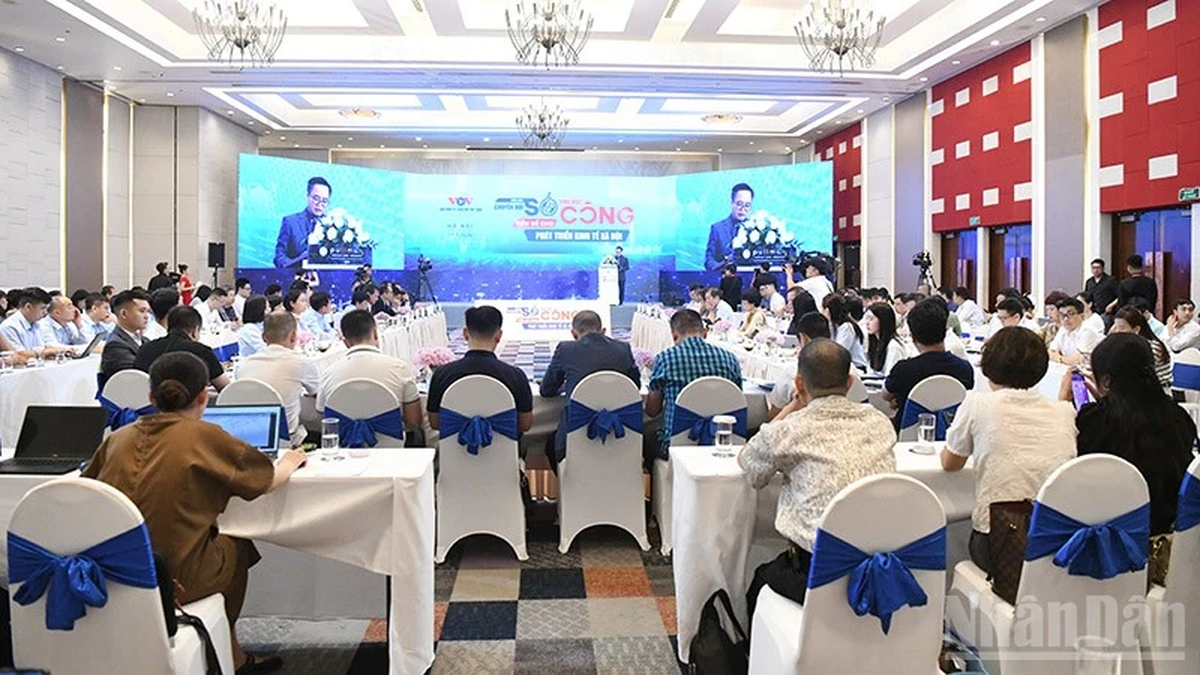Currently, hostile and reactionary forces are trying to sabotage the construction of socialism in Vietnam. They continuously disseminate articles with false content, distorting the truth and misrepresenting Marxism-Leninism and Ho Chi Minh's thought in order to cause social instability. The plots and tricks of hostile and reactionary forces are becoming more dangerous and vicious in the context of the Fourth Industrial Revolution, when information and communication technology is developing strongly, the speed of information dissemination is faster, wider and deeper to all subjects in society. Developing a socialist-oriented market economy in Vietnam is a major policy of our Party and State, creating a favorable environment to mobilize, allocate and effectively use resources, promote investment, production and business, for the goal of "a rich people, a strong country, democracy, fairness and civilization". However, the socio-economic development has not been commensurate with the country's potential and advantages. Many difficulties and challenges still exist. Resolutely and persistently building and developing a socialist-oriented market economy in Vietnam must ensure both the socialist orientation and the construction of a modern, internationally integrated market economy that operates fully and synchronously according to the laws of the market economy.
Socialist-oriented market economy in Vietnam - a creative development model, the result of absorbing human civilization suitable to Vietnam's conditions
Firstly, any country or nation can receive and enjoy the achievements and common, universal values of the market economy - the fruit of human civilization.
Hostile and reactionary forces distort: there is no socialist-oriented market economy. They associate the market economy with capitalism, consider the market economy as a separate product of capitalism, and associate “market economy” with “socialist orientation” as subjective and voluntaristic, like “water” and “fire”, which cannot be combined. If the phrase “socialist orientation” were removed, the Vietnamese economy would develop even faster and achieve even greater success.
It is necessary to consistently affirm that the market economy is the result of human civilization, formed and developed in the process of human development when the commodity economy has reached a certain level.
As we know, market economy is a highly developed commodity economy where all economic relations are carried out on the market. Although market economy and commodity economy have similarities, they are not identical. Market economy and commodity economy both arise on the basis of social division of labor and relative economic separation between commodity producers (1) , which originates from the appearance of private ownership of means of production. Commodity economy emerged very early, from the end of the primitive communal regime, the beginning of the slave-owning regime, when society had all the two conditions mentioned above. The categories (value, price, profit, goods, money), the laws (value, supply - demand, competition, money circulation and inflation) of commodity economy are also the categories and laws of market economy. These categories and laws existed before capitalism and were used by capitalism to develop the capitalist market economy. Thus, the market economy is an achievement of the development of human civilization, carrying common and universal values. Up to now, the market economy has developed through many different stages, in many social regimes, reaching a high level in capitalist society, but this does not mean that the market economy is a unique product of capitalism. As a universal economic model, the development of the market economy is inevitable and objective for all countries and peoples; any country or people can receive and enjoy the common and universal achievements and values of the market economy, and at the same time creatively apply them to suit the specific characteristics, conditions and circumstances of their country or people.
Practice also shows that the market economy arises and develops in many different social regimes and with many different models, such as the unique socialist market economy model in China, the market economy model in Japan, the welfare state market economy model in Sweden and the Nordic countries, the social market economy model in the Federal Republic of Germany, the free market economy model in the United States, etc. In the market economy models in capitalist countries, at different levels and natures, socialist elements are present, whether recognized or not. This shows that the seeds of socialism appear right in the heart of developed capitalist countries.
Going back in time, in the early years of building socialism in Soviet Russia, VI Lenin recognized the problem of identifying the commodity economy with capitalism, not using commodity-money relations to promote production and improve people's lives. From there, VI Lenin proposed and organized the implementation of the "New Economic Policy" (NEP), the basic content of which was to maintain and develop market relations under the management of the proletarian state. The implementation of the new economic policy quickly brought Soviet Russia out of the stagnation of the 1920s; at the same time, it affirmed the reality of the economic model containing the fusion of the market economy and socialism. From the above analysis, it can be affirmed that the market economy and socialist orientation are not at all opposed to each other, and can be fused together to form a general economic model in the transition period to socialism in Vietnam.
Second , ensure socialist orientation and the State's participation in regulating the market economy in Vietnam.
Hostile and reactionary forces distort that the Communist Party of Vietnam accepts the development of a market economy as choosing the path of capitalist development. They distort the policy of encouraging the development of the private economy, considering the private economy an important driving force of the socialist-oriented market economy, thereby assuming that Vietnam is choosing the path of capitalist development. Considering the private economy an important driving force of the socialist-oriented market economy is to ensure the increasing promotion of democracy in economic and social life, gradually improving the investment and business environment, cutting down administrative procedures, ensuring a better conformity of the state management method with the market mechanism, and better protecting property rights and freedom of business of individuals and organizations.
What needs to be affirmed is that determining whether an economy is “socialist” or “capitalist” cannot be based on the criteria of private economy or market regulation, but more importantly, it must be based on the development goals of that economy, for whom, which class, which stratum, what are the operating principles of that economy, as well as the process of formation and development of that economy, who is the real owner of that economy... The socialist-oriented market economy is identified by the Communist Party of Vietnam as “the general model of our country in the transition period to socialism... for the goal of “rich people, strong country, democracy, fairness, civilization” suitable for each stage of the country's development” (2) . The process of forming and developing a socialist-oriented market economy all originates from the interests of the people and the State (when the command economy with a centralized planning mechanism maintained for a long time revealed its limitations and weaknesses, the Communist Party of Vietnam carried out a comprehensive national renovation, advocating the construction and development of a socialist-oriented market economy. Up to now, after nearly 40 years of renovation, our country has achieved great achievements in socio-economic development, increasingly affirming its position in the international arena. Therefore, there are fundamental differences between the capitalist market economy and the socialist-oriented market economy in Vietnam, and the most obvious difference is that in the capitalist market economy, the owners are the capitalists, the bourgeoisie; while in the socialist-oriented market economy in Vietnam, the owners are the people under the leadership of the Party, the management of the people). State law
After nearly 40 years of implementing the renovation process, our country has achieved great achievements in socio-economic development, increasingly affirming its position in the international arena (In photo: Loading and unloading export goods at Saigon port)_Source: nhiepanhdoisong.vn
The socialist-oriented market economy in our country is an economy in the transition period to socialism; many forms of ownership and many economic sectors still exist to mobilize all resources for national development, in which the private economy is identified by our Party as an important driving force. The private economy is encouraged to develop in all industries, occupations, and fields that are not prohibited by law, equal before the law with other economic sectors. The State creates all conditions for the development of the private economy, but does not accept the "privatization" of the economy; the state economy plays a leading role, is an important tool and material force for the State to stabilize the macro-economy, orient, regulate, and lead other economic sectors, promote economic and social development, and maintain the socialist orientation in the development of the market economy. The participation of the State in the role of stabilizing the macro economy, orienting, regulating, leading other economic sectors, and promoting economic and social development is an important requirement to maintain the socialist orientation in the development of the market economy, and is also an important basis to ensure the socialist orientation in the market economy in Vietnam.
The choice of socialist-oriented market economy in Vietnam is completely correct.
To affirm the correctness of choosing a socialist-oriented market economy, two issues need to be clarified. First , why did Vietnam choose a socialist-oriented market economy instead of a command economy with a centralized planning mechanism? Second , the achievements Vietnam has made in building and developing a socialist-oriented market economy.
The first problem , it can be seen, after the country was completely liberated (April 30, 1975), the maintenance of a command economy with a centralized planning mechanism began to reveal its limitations and weaknesses, causing the Vietnamese economy to stagnate: "In the period 1976 - 1980, the average annual growth rate of the total social product only reached 1.4%, national income increased by only 0.4%, while the population increased at an average rate of 2.24%/year. That situation made the lives of all social classes extremely difficult (according to estimates in the 80s of the 20th century, 7 out of 10 Vietnamese people lived in poverty" (3) . That situation posed an urgent need to reshape the thinking about economic development.
The 6th National Congress of the Communist Party of Vietnam (December 1986) marked the beginning of the renovation process in Vietnam, which included the meaning of the Party's first breakthrough in thinking about the market economy, expressed in two main issues: First , rethinking the management mechanism: "The centralized, bureaucratic, subsidized management mechanism for many years has not created a driving force for development, weakening the socialist economy... hindering production, reducing productivity, quality, efficiency, causing disorder in distribution and circulation, and giving rise to many negative phenomena in society" (4) . Second , it proposed the requirement to build a new management mechanism in accordance with objective laws and the level of economic development. It emphasized: the process from small-scale production to large-scale production in our country is the process of transforming an economy that is still self-sufficient and self-sufficient into a commodity economy; with two characteristics of the new management mechanism: "Planning is the number one characteristic of the economic management mechanism... Correct use of commodity-money relations is the second characteristic of the new mechanism of economic management" (5) . The 6th Congress of the Party affirmed: "The essence of the new mechanism of economic management is the planning mechanism according to the socialist business accounting method, in accordance with the principle of democratic centralism " (6) . Thus, by the 6th Congress, the Communist Party of Vietnam had recognized commodity production, that is, recognized the market mechanism, but had not yet considered the Vietnamese economy as a market economy. The Resolution of the 6th Central Conference of the 6th tenure clearly stated: in 1986, the renovation process began..., Vietnam had developed from a planned economy to a market-oriented economy.
In 1991, the 7th National Congress adopted the Platform for National Construction in the Transitional Period to Socialism. The Platform continued to supplement the theory of commodity economy: First , it proposed the policy of "Developing a multi-sector commodity economy with socialist orientation" (7) . Second , "Completely abolishing the centralized bureaucratic and subsidized management mechanism, forming a market mechanism with State management through laws, plans, policies and other tools. Synchronously building and developing markets for consumer goods, materials, services, capital; labor...; carrying out economic exchanges throughout the country and with the world market" (8).
From the perception of the market economy after 15 years of implementing the renovation process, the 9th National Congress of Delegates (2001) officially identified the Vietnamese economy as a "socialist-oriented market economy"; at the same time, pointed out the connotation of the socialist-oriented market economy: "a multi-sector commodity economy operating according to the market mechanism, with state management in a socialist orientation; that is the socialist-oriented market economy " (9) . The purpose of the socialist-oriented market economy is to develop productive forces, develop the economy to build the material and technical foundation of socialism, and improve people's lives.
Thus, the process of awareness and transformation of the thinking of the Communist Party of Vietnam from a command economy with a centralized planning mechanism to a socialist-oriented market economy in Vietnam is a long process, because a socialist-oriented market economy is an unprecedented model in the world. This is a model that we have been doing, learning, and gaining experience from to perfect it into a general economic model in the transition period to socialism. Although the process of perfection is still ongoing, it can be affirmed that Vietnam's choice to develop a market economy on the path to socialism is completely correct. For example, the law of value in a market economy contributes to regulating the production and circulation of goods (industries, occupations, and fields that are efficient and profitable will attract many participants; meanwhile, inefficient industries, occupations, and fields will be narrowed or withdrawn by producers. This phenomenon causes production factors, such as capital, human resources, land, science and technology, etc. to be redistributed, making resources in society more effectively used. In addition, goods are also regulated from places with low prices to places with higher prices, from places where supply is greater than demand to places where supply is less than demand, contributing to regulating the flow of goods on the market). Or under the impact of the law of competition in a market economy, commodity producers must innovate technology to improve labor productivity, reduce individual values, and lower product costs in order to achieve favorable conditions in the production and consumption of goods. With this impact, "producers both pursue their own interests and simultaneously perform an unplanned task of meeting the common interests of society" (10) . Market economy is also an economic model that promotes the dynamism and creativity of production and business entities (to gain more profits, production and business entities must always be dynamic and sensitive in grasping the psychology and tastes of consumers in the market, understanding the art of business, forecasting supply-demand relations, constantly innovating to gain an advantage in production and business...).
Besides the great benefits that the market economy brings, it is necessary to realize that the market economy also contains defects that it cannot overcome: social polarization into two poles, the potential for economic crisis, and destruction of the ecological environment (because in the market economy, production and business entities often tend to pursue pure profit, with little concern or even “evasion” of responsibility for protecting the ecological environment)… That defect requires the presence of the State with the role of creating and establishing institutions. This is the reason to affirm why it is necessary to orient the market economy in Vietnam towards socialism . In developing a socialist-oriented market economy, the role of the State is clearly defined in the Resolution of the 5th Central Conference, Session XII (Resolution No. 11-NQ/TW), dated June 3, 2017, "On perfecting the socialist-oriented market economic institution": "Orienting, building and perfecting the economic institution, creating an equal, transparent and healthy competitive environment; using the State's tools, policies and resources to orient and regulate the economy, promote production and business and protect the environment; implementing social progress and equity in each step and each development policy". The socialist orientation is reflected in each policy, plan and strategy for socio-economic development of the country. Policies, plans and strategies for socio-economic development of the country aim to achieve the goals and tasks of each stage in the process of building socialism; consistent with the market mechanism and ensuring modernity. Modernity is expressed in the selective inheritance of achievements in the development of the market economy of mankind; market elements, types of markets are synchronized and operate smoothly, linked to world economies.
Second issue , it can be seen that after nearly 40 years of implementing the renovation process, the policy of building and developing a socialist-oriented market economy of our Party, State and people has achieved extremely great and undeniable success:
Regarding the size of the economy : “The average growth rate is about 7% per year. Vietnam has been out of the group of low-income countries since 2008. The GDP scale at current prices in 2023 will reach about 10.22 million billion VND, equivalent to 430 billion USD. GDP per capita in 2023 at current prices will reach about 101.9 million VND/person, equivalent to 4,284 USD, an increase of 160 USD compared to 2022” (11) . “Vietnam's current gross domestic product includes about 27% from the state economy, 4% from the collective economy, 30% from the household economy, 10% from the domestic private economy and 20% from the foreign-invested sector” (12) .
Regarding import and export activities : “Export turnover has been constantly increasing, contributing an important part to GDP growth. If in 1986, the total export turnover only reached 789 million USD, then in 2006, exports reached over 39 billion USD and since joining the World Trade Organization (WTO), export turnover has been constantly increasing, reaching 355.5 billion USD in 2023. In terms of structure, export items are increasingly rich and diverse, with many “key” groups of goods achieving large turnover. Many export items have large volumes and turnovers ranking high in the world. If in 1986, we did not have any export items with a value of over 200 million USD, now there are many items with turnovers exceeding 1 billion USD, 5 billion USD” (13) . Up to now, our country has had trade relations with 224 partners; has negotiated, signed and implemented 17 FTAs. Vietnam has become one of the leading countries in the region in forming multilateral economic cooperation frameworks” (14) .
Processing shrimp for export at the factory of Minh Phu Seafood Corporation_Photo: VNA
Regarding social security : Social security has achieved many important results, especially in education, health care, and support for people in difficult circumstances. “Many previously common diseases have been successfully controlled. The poor, children under 6 years old, and the elderly are provided with free health insurance. The rate of malnutrition in children and infant mortality has decreased nearly three times. By April 2022, the whole country had 5,706/8,227 communes meeting new rural standards, of which 663 communes met advanced standards and 71 communes met model standards” (15).
The achievements in building and developing a socialist-oriented market economy confirm that Vietnam's choice of a socialist-oriented market economy is completely correct, in accordance with objective laws and the trend of the world economy, meeting the requirements of national economic development and building a material and technical foundation in the transitional period to socialism in Vietnam.
***
The practice of innovation in our country has convincingly demonstrated the application of the market economic model as a means of building socialism. A socialist-oriented market economy is an economy in which institutions, tools and principles of market economic operation are created and used to completely liberate productive forces, gradually improve people's lives, for the goal of "rich people, strong country, democracy, equality and civilization". In order to promote the development and perfection of the socialist-oriented market economic model in Vietnam in the coming time, it is extremely important to propagate and raise awareness among the entire Party and people about the characteristics, nature and goals of the socialist-oriented market economy in Vietnam. Besides, it is necessary to resolutely and uncompromisingly fight and refute the wrong arguments of hostile and reactionary forces against the socialist-oriented market economy in order to protect the Party's ideological foundation, protect and promote the achievements in the process of building and developing the socialist-oriented market economy in Vietnam./.
---------------
(1) Textbook of Marxist-Leninist Political Economy , National Political Publishing House, Hanoi, 2008, pp. 114 - 115
(2) Documents of the 13th National Congress of Delegates , National Political Publishing House Truth, Hanoi, vol. I, p. 128
(3) Le Thi Que: From thinking to practice: 15 years of "transformation" of Vietnam's economy (1986 - 2001), Journal of Economic Research , No. 354 (11-2007), p. 60
(4), (5) Documents of the 6th National Congress of Delegates , Truth Publishing House, Hanoi, 1987, pp. 62, 63
(6) Documents of the 6th National Congress of Delegates , op. cit. , p. 65
(7), (8) Party documents: Complete , Publishing House. National politics, Hanoi, 2007, t. 51, p. 137, 138
(9) Document of the 9th National Congress Congress , Publishing House. National politics, Hanoi, 2001, p. 86
(10) History curriculum of economic theories , Publishing House. National Economics University, Hanoi, 2009, p. 73
.
(12) Nguyen Phu Trong: A number of theoretical and practical issues about socialism and the path to socialism in Vietnam , Publishing House. National politics truth, Hanoi, 2022, p. 31
(13) International Finance Committee and Integration Policy, Strategy Institute and Financial Policy: The results achieved after 30 years of renovation of international economic integration, Electronic Portal of the Ministry of Finance , May 30-2023, https://mof.gov.vn/webcenter/portal/btcvn/pages_r/l/tin-bo-tai-chinh ?
(14) Nguyen Thuy: The imprints of Vietnamese trade after more than 35 years of renovation, on December 19-2022, https://www.tuyengiao.vn/nhung-dau-an-cua-thuong-mai-viet-nam-sau-hon-35-nam-doi-moi-146918
(15) Nguyen Trong Nghia: Achievements of developing a socialist-oriented market economy in Vietnam over 35 years of renovation, Communist Magazine , No. 1008 (2-2023), p. 3
Source: https://tapchicongsan.org.vn/web/guest/kinh-te/-/2018/1107403/nen-kinh-te-thi-truong-dinh-huong-hoi-chu-nghia-o-vi-vi Et-Nam --- Su-Dot-Pha%2C-Sang-Tao-VE-TU-DUY-LUAN-LUAN-CUA-DANG%2C-DUA-DAT-NUOC-KHANG-DINH-VE-VE-TREN-TRUONG-QUC-TE.ASPX







































































































Comment (0)